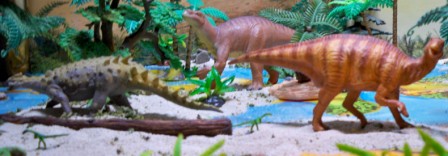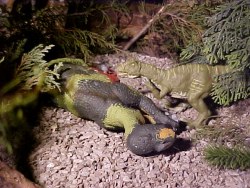
Early Cretaceous
Australia
from the Dinosaur Collector
UPDATED 122209 proof 020606 rgk
During the Mesozoic Australia was at the end of the world, attached to the end of a long peninsula of Gondwanaland. This isolation seems to have allowed older forms like allosaurids and labyrinthidonts to exist when they had become extinct elsewhere. Fossil remains are often very scrappy and several species have been identified based on single bones or even footprints. During the Cretaceous, Australia and Antarctica began to separate, sea levels rose and a large inland sea developed.
Two kinds of sauropods are known from Early Cretaceous Queensland; one remains unidentified, and the other is Austrosaurus (Southern Reptile), estimated as 45 feet long and classified as a cetiosaurid based on incomplete fossils and several vertebrae. The body is thought to resemble that of Brachiosaurus. Footprints and bone fragments prove other sauropods lived in Australia.
Use the scroll bar to view the panoramic shot of Austrosaurus from the Cadbury Yowie series, Diplodocus from the National Geographic Micro Machines set, Safari Habitat Diplodocus, and Play Vision Apatosaurus.
Closed forests habitats were common in the temperate climate, and this may account for the small size of the dinosaurs found there. Minmi was named after a location in Australia and was about 10 feet long. This is small for an ankylesaurid and Minmi doesn't seem to belong to either the nodosaur or ankylosaur families. It and the iguanodontid Muttaburrasaurus are two of the best-known Australian dinosaurs coming from relatively complete skeletons.
Use the scroll bar to view the panoramic shot. Two Allosaurus from National Geographic Micro Machines, two Yowie Muttaburrasaurus, two Disney Kron iguanodon, and Minmi (an ankylosaur) from a set of gumball figures. To the far right another Yowie allosaurid.
Muttaburrasaurus, reaching 23 feet long, was a plant eater (possibly an omnivore) and often found in marshy areas. It had an intriguing and unique large bump on its nose, and walked on all fours, although able to stand on its rear legs. It had teeth designed for shearing rather than grinding, and a snout featuring a distinctively expanded hollow chamber, with large external nostrils that may have served as cooling chambers. The Dwarf Allosaurus is a controversial species known from a leg bone and made famous in the Walking with Dinosaurs documentary. Its length is estimated at about 19 feet.

Invicta painted Muttaburrasaurus and HLBS Dwarf Allosaurus in the style of the WWD documentary.
Muttaburrasaurus is often referred to as an iguanodontid, but it may be more closely related to Dryosaurus and Tenontosaurus. The thumb spike seems to also be questionable.

Procon Minmi and Muttaburrasaurus Invicta painted Muttaburrasaurus
Minmi was a plant eater, this was the first undoubted southern hemisphere ankylosaur, and the first anywhere with bony plates developing in the body wall. Its spine had special plates and bone rods that may have taken the strain and enabled Minmi to run rapidly. This animal has a strange mixture of ankylosaurid and nodosaurid features, and may well finish up in its own family. It is usually not classified beyond ankylosauria.
Science and Nature Allosaurus, Muttaburrasaurus and Minmi.
Australia has representatives of several dinosaur families and one large carnosaur an unidentified allosaurid. The Australian allosaurid , as well as being smaller, also occurs some 50 million years later than the North American specimens.

Custom Muttaburrasaurus and Dwarf Allosaurus in WWD colors created and submitted by Stephen Robertson.
Leaellynasaura, a small turkey-sized vegetarian, was a hypsilophodont (a wide spread group). Their fossils tend to be rare in areas where other, larger dinosaurs are found. Hypsilophodonts are usually found in harsh environments that are unattractive to larger animals, like the uplands of North America and various island environments. The brain case suggests that Leaellynasaura has well-developed eyes even night vision. This characteristic would have been an advantage during the dark arctic winters.
Leaellynasaura from the Toyway WWD series. The Kinto diorama base courtesy of Toyosaurus.
Although southern Australia was originally thought to be too cold for dinosaurs, early in the 1980's abundant finds of hypsilophodontids and traces of a big allosaurid carnosaur were unearthed on the south coast (Cape Paterson, near Inverloch, and Dinosaur Cove on the Otway Ranges coast, both in Victoria), suggesting that dinosaurs were still migrating to Australia in the Cretaceous period. Not only was it cold, but probably dark for some 3 months of the year. This has led to speculation that the dinosaurs were probably warm blooded and may well have grown fur or feathers to help keep warm. Leaellynasaura was an intelligent, large-eyed dinosaur with large eyes may have helped it to help it see in the partial dark that occurred for long periods in Australia at the time due to its closeness to the South Pole.
Leaellynasaura Science and Nature.
Back to the Mesozoic Menu
Click on the Site A icon to the right for Dioramas organized by period or by manufacturer.